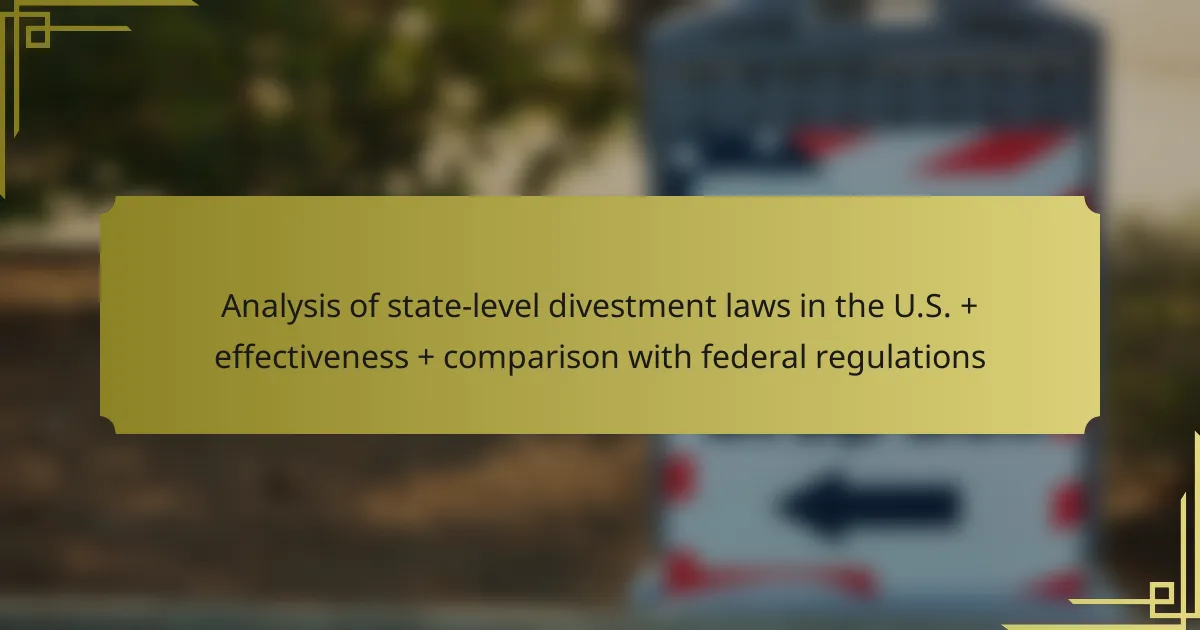State-level divestment laws in the U.S. are regulations that mandate or encourage state governments to withdraw investments from specific sectors, particularly those associated with fossil fuels, tobacco, or human rights violations. As of 2023, more than 30 states have enacted such laws, primarily affecting pension funds and public investments, with varying degrees of financial impact reported. The article analyzes the effectiveness of these divestment laws, challenges in implementation, and the potential influence on federal policies. It also highlights the growing trend towards stricter regulations and broader social justice criteria in state-level divestment efforts, driven by increased public awareness of environmental and social issues.

What are state-level divestment laws in the U.S.?
State-level divestment laws in the U.S. are regulations that require or encourage state governments to withdraw investments from certain sectors or companies. These laws often target industries such as fossil fuels, tobacco, or companies involved in human rights violations. The objective is to align state financial practices with social or environmental goals. As of 2023, over 30 states have enacted some form of divestment legislation. Many of these laws focus on pension funds and public investments. The effectiveness of these laws varies, with some states reporting significant financial impacts. Studies show that divestment can influence corporate behavior and public awareness.
How do state-level divestment laws differ from federal regulations?
State-level divestment laws focus on specific local issues, while federal regulations address broader national concerns. State laws often target particular industries or companies, such as fossil fuels or private prisons, reflecting local priorities. Federal regulations, on the other hand, apply uniformly across states and often encompass larger economic or environmental policies. Additionally, state laws can vary significantly in their implementation and enforcement, while federal regulations maintain a consistent framework. This divergence allows states to respond to their unique contexts, but it can also lead to a patchwork of regulations across the country. For example, as of 2021, California has enacted stringent divestment laws targeting fossil fuels, while other states may have no such measures.
What are the key characteristics of state-level divestment laws?
State-level divestment laws primarily aim to restrict investments in certain industries or entities. These laws often target sectors like fossil fuels, firearms, or companies involved in human rights violations. They are enacted by state legislatures and can vary significantly across states. Many of these laws require state pension funds to divest from specific companies. Some states implement these laws to align investments with social and environmental goals. The laws may also include provisions for transparency and reporting on divestment activities. As of 2023, over 20 states have enacted some form of divestment legislation. These laws reflect a growing trend towards socially responsible investing at the state level.
What common themes exist across various state-level divestment laws?
Common themes across various state-level divestment laws include a focus on social responsibility, environmental protection, and economic factors. Many states aim to divest from industries associated with fossil fuels, tobacco, and firearms. These laws often reflect public sentiment and advocacy for sustainability. Additionally, there is a trend towards transparency and accountability in investment decisions. States frequently establish criteria for evaluating investments based on ethical considerations. Legislative frameworks typically involve collaboration with stakeholders, including community organizations. Overall, these laws represent a growing movement towards aligning state investments with broader societal values.
Why are state-level divestment laws implemented?
State-level divestment laws are implemented to reduce investments in specific industries, particularly fossil fuels. These laws aim to address climate change and promote environmental sustainability. By divesting, states seek to align their financial practices with social and environmental values. Additionally, such laws can encourage companies to adopt more sustainable practices. Evidence suggests that divestment can impact the financial performance of targeted industries. For instance, the Global Carbon Project reported that fossil fuel emissions are a major contributor to climate change, prompting states to take action. Overall, state-level divestment laws reflect a growing commitment to environmental responsibility and social justice.
What motivations drive states to adopt divestment laws?
States adopt divestment laws primarily to align investment practices with social and environmental values. Economic factors also play a role, as states seek to mitigate financial risks associated with fossil fuel investments. Public pressure and advocacy from constituents drive legislative action. Additionally, states may aim to enhance their reputations as leaders in sustainability. Studies indicate that divestment can influence corporate behavior by reducing capital access for certain industries. For instance, the University of California’s divestment from fossil fuels aimed to set a precedent for similar actions nationwide. Overall, the motivations encompass ethical, economic, and reputational considerations.
How do public opinion and activism influence state-level divestment laws?
Public opinion and activism significantly shape state-level divestment laws. When a substantial portion of the public expresses concern over specific issues, such as climate change or social justice, lawmakers often respond. Activist groups mobilize citizens to advocate for divestment from industries like fossil fuels or tobacco. This grassroots pressure can lead to legislative proposals and changes in state policies. Historical instances, like the divestment movement against apartheid in South Africa, demonstrate how public sentiment can drive legislative action. Research shows that states with active advocacy campaigns often see faster adoption of divestment laws. Consequently, public opinion and organized activism create a compelling case for lawmakers to prioritize divestment initiatives.
What is the effectiveness of state-level divestment laws?
State-level divestment laws are effective in influencing investment behaviors and promoting social change. These laws often target specific industries, such as fossil fuels or tobacco. By restricting state investments, they can pressure companies to adopt more sustainable practices. Research indicates that states with divestment laws see a measurable decrease in investments in targeted sectors. For instance, a 2021 study by the University of California found that states with divestment laws reduced fossil fuel investments by approximately 30%. This demonstrates a direct correlation between state-level policies and investment shifts. Overall, state-level divestment laws can significantly impact corporate behavior and investment patterns.
How can the effectiveness of divestment laws be measured?
The effectiveness of divestment laws can be measured through various quantitative and qualitative metrics. Quantitative metrics include the amount of capital withdrawn from targeted sectors. This can be assessed by analyzing financial reports and investment flows before and after the implementation of the laws. Qualitative metrics involve stakeholder perceptions and the extent of compliance among institutions. Surveys and interviews can provide insights into these perceptions. Additionally, the impact on the targeted sectors’ performance can be evaluated through market analysis. Studies have shown that divestment can influence public opinion and corporate behavior, further validating the measurement of effectiveness. For example, a report from the University of California found that divestment led to significant shifts in investment patterns and stakeholder engagement.
What case studies highlight successful or unsuccessful divestment efforts?
The case study of South Africa’s anti-apartheid movement illustrates successful divestment efforts. In the 1980s, universities and pension funds withdrew investments from companies operating in South Africa. This collective action contributed to political pressure that helped end apartheid.
Conversely, the case of fossil fuel divestment efforts shows mixed results. Some institutions, like Stanford University, successfully divested from coal companies. However, many others, including Harvard University, faced challenges and chose not to divest. This has led to ongoing debates about the effectiveness of divestment as a strategy for social change.
A report by the Institute for Energy Economics, Japan, highlights that while divestment can signal a commitment to social issues, it does not always lead to significant financial impact on the targeted industries. Thus, the effectiveness of divestment efforts varies significantly based on context and stakeholder engagement.
How do state-level divestment laws interact with federal regulations?
State-level divestment laws can coexist with federal regulations but may face limitations. Federal law generally preempts state law when there is a conflict. This means if a federal regulation prohibits certain actions, state divestment laws cannot override that prohibition. However, states have the authority to enact divestment laws that align with federal standards. For instance, states can choose to divest from certain industries without conflicting with federal rules. A notable example is the varied state responses to fossil fuel investments, where some states have pursued divestment while federal policies remain neutral. The interaction is complex, as state laws can influence federal discussions but must operate within the constraints of existing federal regulations.
What are the legal implications of state versus federal divestment policies?
State and federal divestment policies have distinct legal implications. States have the authority to implement their own divestment strategies, which can lead to conflicts with federal regulations. Federal policies may preempt state actions if they conflict with national interests or laws. For example, the federal government can restrict state divestment in certain sectors deemed vital for national security. Additionally, state divestment policies can face legal challenges based on the doctrine of preemption. Courts may rule that state laws are invalid if they interfere with federal law. Thus, the legal landscape surrounding divestment policies is complex and requires careful navigation of both state and federal frameworks.
How do federal regulations impact the enforcement of state-level divestment laws?
Federal regulations can significantly limit the enforcement of state-level divestment laws. These regulations often preempt state actions, particularly in areas related to finance and commerce. For instance, federal laws like the Employee Retirement Income Security Act (ERISA) restrict states from imposing certain investment restrictions on pension funds. This creates a legal framework where state-level divestment efforts may face challenges in court. Additionally, federal agencies may issue guidelines that discourage or complicate state divestment initiatives. The interplay between federal authority and state autonomy thus shapes the effectiveness of state-level divestment laws.

What challenges do states face in implementing divestment laws?
States face several challenges in implementing divestment laws. One major challenge is the legal complexity surrounding investment decisions. States must navigate existing contracts and fiduciary responsibilities. These legal obligations may hinder timely divestment actions. Another challenge is the potential financial impact on state pension funds. Divestment could lead to reduced returns, affecting beneficiaries. Additionally, political opposition can arise from stakeholders who favor maintaining investments. This opposition may complicate the legislative process. Public awareness and support are also critical. Without strong public backing, efforts to pass divestment laws may falter. Finally, coordination among various state agencies can be difficult. Effective implementation requires collaboration, which is often lacking.
What legal challenges have arisen regarding state-level divestment laws?
State-level divestment laws face several legal challenges. One significant challenge is the argument that these laws violate the First Amendment rights of companies. Critics claim that compelled divestment based on political or social issues infringes on free speech. Another challenge involves claims of preemption. Opponents argue that state laws conflict with federal regulations, particularly in areas like foreign policy and trade. Additionally, legal disputes often arise over the interpretation of fiduciary duties. Some argue that divestment could harm the financial interests of pension funds. Recent court cases have highlighted these issues, demonstrating the ongoing legal complexities surrounding state-level divestment laws.
How do conflicts with federal laws create obstacles for states?
Conflicts with federal laws create obstacles for states by undermining state authority and complicating legal compliance. When state laws contradict federal regulations, states may face legal challenges. This can lead to costly litigation and uncertainty for state officials. For instance, the Supremacy Clause of the U.S. Constitution establishes that federal law prevails over state law. Consequently, states may be forced to amend or repeal laws that conflict with federal statutes. This dynamic can hinder states’ ability to implement their own policies effectively. Additionally, federal funding may be contingent on compliance with federal laws, further restricting state autonomy. Historical examples include states attempting to regulate marijuana despite federal prohibition. These conflicts illustrate the complexities states navigate when federal laws impose limitations on their legislative actions.
What role do financial institutions play in these challenges?
Financial institutions play a significant role in the challenges associated with state-level divestment laws. They influence investment decisions and funding availability for various sectors. Financial institutions often assess the risks and returns of investing in states with divestment laws. Their actions can impact the effectiveness of these laws by either supporting or opposing them through capital allocation. For instance, banks may choose to withdraw funding from industries targeted by divestment efforts, affecting their operational capabilities. Additionally, financial institutions can lobby for or against state regulations, shaping the political landscape. The response of these institutions can either reinforce or undermine the goals of state-level divestment laws. Their involvement is crucial in determining the overall effectiveness of such regulations in achieving desired outcomes.
How do states measure the impact of their divestment laws?
States measure the impact of their divestment laws through various metrics and assessments. They analyze financial performance indicators, such as changes in investment returns. States also track shifts in capital flows related to divested sectors. Legislative reports often include assessments of economic impacts on local job markets. Surveys may gauge public sentiment towards divestment initiatives. Additionally, states may compare their outcomes against similar jurisdictions. Academic studies can provide external evaluations of the laws’ effectiveness. Ultimately, these methods help states understand the broader implications of their divestment strategies.
What metrics are used to assess the effectiveness of divestment laws?
Metrics used to assess the effectiveness of divestment laws include financial performance, compliance rates, and environmental impact. Financial performance measures the economic outcomes of divestment strategies. Compliance rates track adherence to the laws by relevant entities. Environmental impact assesses the reduction of carbon emissions or other ecological benefits resulting from divestment. Additional metrics may include public awareness levels and shifts in investment patterns. These metrics provide a comprehensive evaluation of how well divestment laws achieve their intended goals.
How do states report on the outcomes of their divestment initiatives?
States report on the outcomes of their divestment initiatives through various methods. These include annual reports, public disclosures, and legislative updates. Many states provide detailed documentation of financial performance and social impact. Reports often include metrics such as total assets divested and projected financial savings. Some states utilize online platforms for transparency and accessibility. Specific examples include California’s annual reports on fossil fuel divestment outcomes. These reports are often mandated by state laws or executive orders. Overall, states emphasize accountability and public engagement in their reporting processes.

What are the future trends for state-level divestment laws?
State-level divestment laws are expected to trend towards increased adoption and stricter regulations. Many states are focusing on divesting from fossil fuels and companies with poor environmental records. This shift is driven by growing public awareness of climate change and sustainability issues. Legislative efforts are likely to expand to include broader social justice criteria. Increased collaboration among states may lead to a unified approach to divestment. Additionally, state-level divestment laws may influence federal policies in the future. Historical data shows a rise in state-level actions over the past decade. For example, as of 2022, over 20 states have enacted some form of divestment legislation.
How might state-level divestment laws evolve in response to changing political climates?
State-level divestment laws may evolve significantly due to changing political climates. Shifts in political leadership can influence the prioritization of environmental, social, and governance (ESG) issues. For instance, states with progressive leadership may increase divestment from fossil fuels in response to climate change concerns. Conversely, conservative administrations might roll back such initiatives, focusing on economic growth. Historical trends show that states like California and New York have enacted stronger divestment laws under Democratic governance. Data from the 2020 elections indicated a rise in pro-divestment measures in states with Democratic majorities. Therefore, the political landscape directly impacts the development and enforcement of divestment laws.
What emerging issues could influence future divestment legislation?
Emerging issues that could influence future divestment legislation include climate change, social justice movements, and economic considerations. Climate change is prompting states to divest from fossil fuels to reduce carbon emissions. Social justice movements are driving divestment from companies involved in human rights abuses. Economic considerations, such as financial performance and risk management, are leading to increased scrutiny of investment portfolios. These factors reflect a growing awareness of the impact of investments on society and the environment. Recent trends show that states are increasingly adopting legislation that aligns with these emerging issues. For example, California’s divestment from coal companies illustrates this shift.
How can states prepare for potential shifts in federal policy regarding divestment?
States can prepare for potential shifts in federal policy regarding divestment by proactively reviewing and updating their divestment laws. This includes assessing current state investment portfolios to identify vulnerabilities related to changing federal regulations. States should also engage with legal experts to understand the implications of federal policy shifts on state laws.
Establishing a communication strategy with stakeholders is essential to ensure transparency during policy changes. States may consider forming coalitions with other states to share resources and strategies for collective action. Monitoring federal legislative developments will allow states to anticipate changes and respond swiftly.
Finally, states can conduct impact assessments to evaluate how federal shifts may affect local economies and investment strategies. Historical examples show that states that adapt quickly to federal changes can mitigate risks and maintain investment stability.
What best practices can states adopt for effective divestment laws?
States can adopt clear guidelines for divestment laws to ensure effectiveness. These guidelines should define specific criteria for divestment, such as environmental, social, and governance (ESG) factors. States should also implement transparent processes for decision-making and reporting. Regular evaluations of divestment impacts can enhance accountability. Engaging stakeholders, including communities and investors, fosters broader support. Additionally, states should coordinate with federal regulations to avoid conflicts. Research indicates that states with robust frameworks see better outcomes in achieving divestment goals. For example, California’s divestment from fossil fuels has set a precedent for other states.
What lessons can be learned from successful state-level divestment initiatives?
Successful state-level divestment initiatives demonstrate the importance of clear objectives and stakeholder engagement. These initiatives often focus on specific goals, such as reducing fossil fuel investments to combat climate change. Engaging stakeholders, including community members and organizations, fosters broader support and participation.
Effective communication strategies are crucial in conveying the rationale behind divestment. States that successfully implemented these initiatives often utilized data-driven arguments to highlight the financial and ethical implications of their investments.
Monitoring and transparency also play significant roles in successful divestment efforts. Regular updates on progress and impacts help maintain public trust and accountability.
For instance, California’s divestment from tobacco companies in the 1990s resulted in significant financial gains and public health benefits. This case illustrates the potential for positive outcomes when divestment is aligned with social responsibility goals.
Overall, successful divestment initiatives highlight the need for strategic planning, stakeholder involvement, and transparent communication to achieve desired outcomes.
How can collaboration between states enhance the effectiveness of divestment laws?
Collaboration between states can enhance the effectiveness of divestment laws by creating a unified approach to investment policies. When states work together, they can share best practices and strategies that have proven successful. This collaboration can lead to more comprehensive and coherent regulations across state lines. Additionally, joint initiatives can amplify the impact of divestment efforts, making it harder for targeted industries to operate without compliance. For instance, states that align their divestment laws can collectively influence market behavior and investment trends. Research indicates that coordinated actions among multiple states can lead to significant shifts in corporate accountability and sustainability practices. Such collaboration can also increase political pressure on companies to adhere to ethical standards.
State-level divestment laws in the U.S. are regulations that mandate or encourage state governments to withdraw investments from specific sectors, particularly those linked to fossil fuels, tobacco, and human rights violations. The article analyzes the characteristics, motivations, and effectiveness of these laws, highlighting their impact on corporate behavior and public awareness. It compares state-level regulations with federal policies, addressing the challenges states face in implementation and the legal complexities involved. Additionally, the article explores future trends, best practices, and the potential for collaboration among states to enhance the effectiveness of divestment initiatives.


